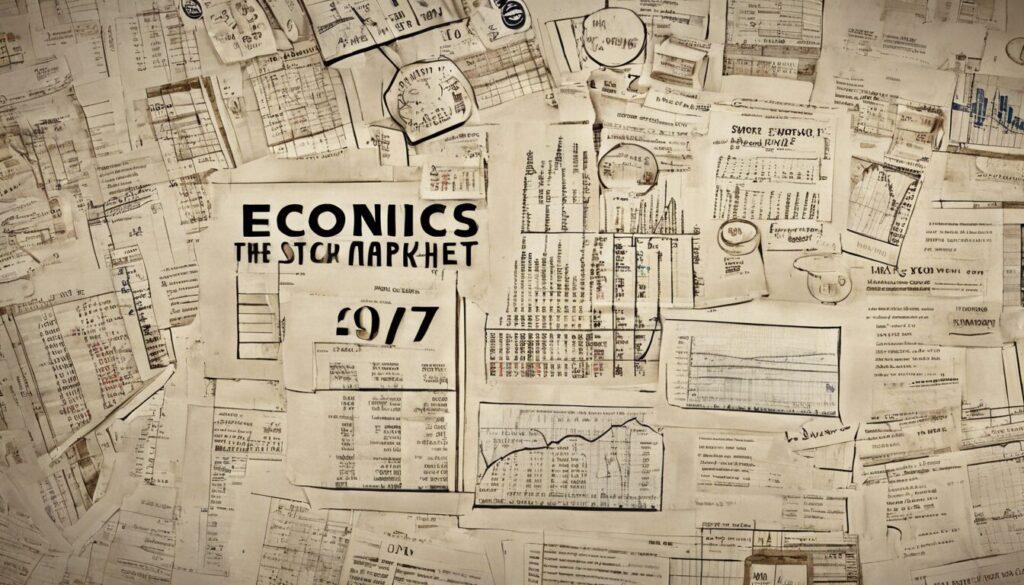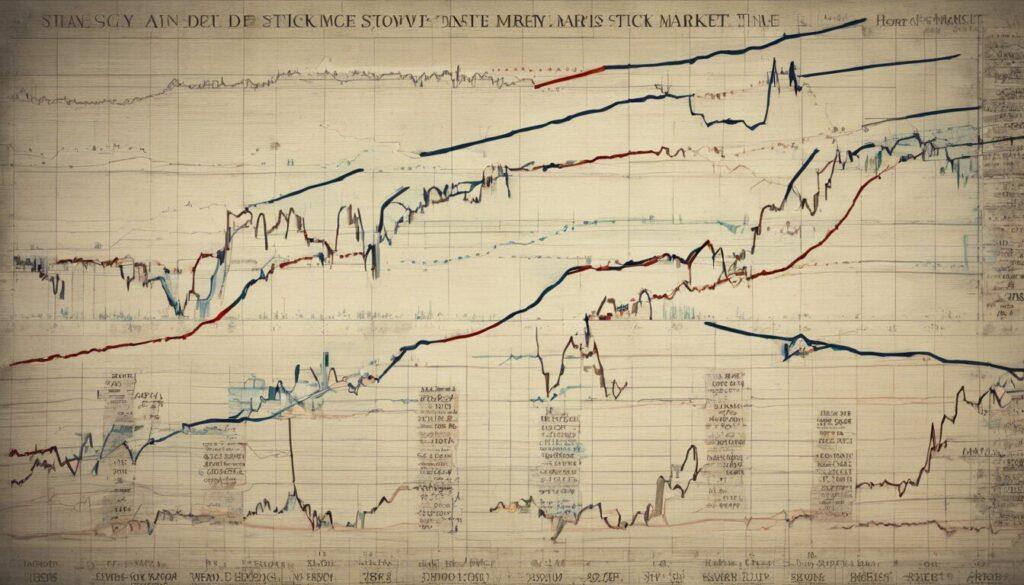Understanding Economics and the Stock Market: A Comprehensive Guide
In this second’s dynamic financial panorama, the intricacies of economics and the stock market are important for consumers, professionals and anyone concerned in the functioning of worldwide markets. By filling in the gaps in the current literature and providing current views, this thorough data seeks to investigate these matters in a pleasant component.
Understanding Economics and the Stock Market: A Comprehensive GuideIntroduction to Economics and the Stock Market
Economics and the stock market are deeply intertwined. Understanding their relationship helps consumers make educated choices and anticipate market developments. This data covers the elementary concepts, current developments and smart features associated to every discipline.

Key Concepts in Economics
1. Basic Economic Principles
- Supply and Demand: The elementary monetary maneuver explains how prices and parts of merchandise and corporations are determined in a market financial system.
- Market Equilibrium: The stage at which the quantity demanded equals the quantity offered.
- Elasticity: Measures how the quantity demanded or offered of a superb responds to changes in worth.
2. Economic Indicators
- Gross Domestic Product (GDP): A measure of a country’s monetary efficiency.
- Inflation: The value at which the fundamental stage of prices for gadgets and corporations is rising.
- Unemployment Rate: The proportion of the labor drive that is jobless and actively looking for employment.
3. Economic Theories and Models
- Keynesian Economics: Focuses on entire spending in the financial system and its outcomes on output and inflation.
- Classical Economics: Emphasizes free markets, minimal authorities intervention and the long-term outcomes of market equilibrium.
- Monetarism: Centers on the place of governments in controlling the sum of cash in circulation.
The Stock Market: An Overview
1. Understanding Stock Markets
- Definition: An stock market is a bunch of markets by which shares (shares of possession in corporations) are bought and purchased.
- Major Exchanges: This comprises the New York Stock Exchange (NYSE), NASDAQ and London Stock Exchange (LSE).
2. How the Stock Market Works
- The dynamics of provide and demand, agency effectivity and monetary elements all have an effect on stock prices.
- Market Indices: Aggregated measures of stock effectivity resembling the S&P 500, Dow Jones Industrial Average and NASDAQ Composite.
- Fundamental analysis determines the intrinsic value of a listing by inspecting its financial statements, commerce standing and basic state of the financial system.
- Technical Analysis: Uses historic worth information and shopping for and promoting volumes to predict future worth actions.
- Diversification: Spreads investments all through quite a few sectors to chop again on threats.

Current Trends and Data
1. Impact of Technology on Markets
- Algorithmic Trading: Automated shopping for and promoting strategies that use algorithms to make high-speed shopping for and promoting selections.
- Fintech Innovations: The rise of economic expertise instruments resembling robo-advisors and blockchain.
- Geopolitical Events: How political instability and worldwide relations have an effect on markets.
- Climate Change: The rising significance of environmental, social and governance (ESG) elements in funding selections.
3. Post-Pandemic Market Dynamics
- Recovery Trends: Analyzing how utterly totally different sectors are bouncing once more from monetary disruptions introduced on by the COVID-19 pandemic.
- Remote Work and Its Effects: The shift in course of distant work and its implications for the precise property and experience sectors.
Practical Advice for Investors
1. Building a Portfolio
- Risk Tolerance: Assessing your capability to endure market volatility.
- Investment Goals: Aligning investments collectively together with your long-term financial targets.
- Emotional Investing: Avoid making selections primarily based totally on short-term market actions or emotions.
- Lack of Research: Conduct thorough analysis earlier than investing in shares or totally different financial units.
3. Staying Informed
- Economic Reports: Regularly reviewing monetary indicators and financial data.
- Continuous Learning: Engaging in educational belongings and financial literacy functions.
Conclusion
Understanding the fundamentals of economics and the inventory market is vital for making educated financial selections. Through diligent exploration of these matters and ongoing consciousness of the newest developments, people can improve their funding approaches and deftly maneuver the intricacies of the fashionable financial panorama.
Internal Linking Opportunities
- Economic Indicators Explained: Link to an in-depth net web page about quite a few monetary indicators.
- Investing Strategies 101: Link to an online web page overlaying utterly totally different investing strategies in depth.
- Understanding Market Indices: Link to a helpful useful resource explaining primary stock market indices.
External Authoritative Sources
- Investopedia: Basic Economic Principles: An Overview of Essential Economic Concepts.
- The Wall Street Journal: Market Trends: To hold updated with the latest market developments and data,
- Bureau of Economic Analysis: GDP Data: Official information on GDP and monetary effectivity.
- For detailed advice and investment strategies, visit Morningstar: Investment Strategies.
- World Bank: Global Economic Outlook: Insights into world monetary circumstances and forecasts.
This article offers a whole and up-to-date have a look at economics and the stock market, filling gaps in current content material materials and offering actionable insights for readers.

Frequently Asked Questions (FAQ) about Economics and the Stock Market
1. What are the elementary concepts of economics?
Basic monetary concepts embrace present and demand, market equilibrium and elasticity. Supply and demand clarify how costs and portions of products and corporations are determined. Elasticity measures how worth changes have an effect on the quantity demanded or offered. Market equilibrium is the stage at which the place supplies and calls for is equal.
2. How do monetary indicators impression the stock market?
Economic indicators resembling GDP, inflation and unemployment expenses current insights into the basic well-being of an financial system. A robust GDP progress value, as an example, would possibly level out a thriving financial system, which could bolster investor confidence and enhance stock prices. Conversely, extreme inflation or rising unemployment would possibly level out monetary trouble, doubtlessly leading to a market downturn.
3. What is the place of experience in modern stock markets?
The know-how significantly impacts stock markets by means of algorithmic shopping for and promoting, which makes use of superior algorithms to execute trades at extreme speeds and fintech enhancements like robo-advisors and blockchain, which provide new strategies to deal with investments and enhance transparency.
4. What are some frequent investing strategies?
Common investing methods embrace:
- Fundamental Analysis: Evaluate a listing’s intrinsic value primarily based totally on financial statements and monetary circumstances.
- Technical Analysis: analyzes historic worth and amount information to predict future stock actions.
- Diversification: Spreads investments all through quite a few sectors to scale back menace.
5. How can I assemble a worthwhile funding portfolio?
To assemble a worthwhile funding portfolio, assess your menace tolerance, set clear funding targets and diversify your investments all through utterly totally different asset lessons and sectors. Regularly consider and regulate your portfolio primarily based totally on market circumstances and personal financial targets.
6. What are some frequent pitfalls to steer clear of in investing?
Emotional investing, which might result in snap selections primarily based totally on market fluctuations and an absence of research, which could end in uninformed funding selections, are frequent pitfalls. It’s important to make selections primarily based totally on thorough analysis and long-term goals.
7. How does the COVID-19 pandemic have an effect on the stock market?
The COVID-19 pandemic has led to very important market volatility, affecting quite a few sectors in another way. Some industries, like experience and healthcare, have seen progress, whereas others, resembling journey and hospitality, have confronted challenges. Investors ought to watch restoration developments and sector-specific impacts when making funding selections.
8. What are market indices and why are they very important?
Market indices, resembling the S&P 500, Dow Jones Industrial Average and NASDAQ Composite, combination the effectivity of a selection of shares to produce a abstract of market developments. They are very important for gauging basic market efficiency and evaluating particular person stock effectivity in the direction of a broader market benchmark.
9. How can I hold educated about monetary and market developments?
Staying educated entails repeatedly reviewing monetary tales, financial data and updates from credible sources resembling funding web sites, monetary evaluation organizations and financial data retailers. Continuing education by packages and financial literacy initiatives may also be useful.
10. What are some reliable sources for monetary and stock market information?
Reliable sources embrace:
- Investopedia for monetary concepts and funding strategies.
- The Wall Street Journal for current market developments and information.
- The Bureau of Economic Analysis is accountable for GDP and monetary effectivity information.
- suggestionsMorningstar for funding strategies and suggestions.
- The World Bank for world financial outlook and forecasts.
Originally posted 2024-09-03 12:46:43.


I love this blog, keep posting articles like this!
This post really helped me understand the topic. Thank you!
This article is both informative and enjoyable to read.
I learned a lot from this article, thanks for your expertise.
Thanks for this very useful and well-written post.
A clear and insightful read, keep publishing content like this!
Keep writing such interesting and relevant articles!
Thanks for this very useful and well-written post.
Keep writing such interesting and relevant articles!
It’s so well-written and clear! I really enjoyed this post.
Thanks for sharing this valuable content. Very well structured and easy to read!
Thanks for this post. It’s both comprehensive and easy to understand.
Thank you for this well-structured and clear content. By the way, if you’re looking for more great content, check out this site: https://www.gagnerargent.online/transformer-100-en-1000-euros/.
Your expertise shines through in every sentence, thank you for this post.
Thanks for sharing this valuable and informative content. I’ll be back regularly!
This post really helped me understand the topic. Thank you!
Kudos on this article! It’s packed with useful, well-explained information.
I learned a lot from this article, thanks for your expertise.
You have a unique way of approaching complex topics. By the way, if you’re looking for more great content, check out this site: https://commentgagner.blog/revenus-avec-linvestissement-en-dividendes/.
This post really helped me understand the topic. Thank you!
Thanks for sharing this valuable content. Very well structured and easy to read!
Thank you for this post! I love how you make complex topics easy to understand. By the way, if you’re looking for more great content, check out this site: https://www.finanalys.com/10-must-read-finance-books/.
This post really helped me understand the topic. Thank you!
Keep writing such interesting and relevant articles!
The illustrations and examples add real value to this article, thank you!
This article is incredibly well written! I learned a lot by reading it.
Superb article. I’ve learned so many new things today. Thanks!
It’s always a pleasure to read your posts. Keep educating us!
Your writing is really engaging, I was hooked from start to finish.
You have a unique way of approaching complex topics.
A very insightful analysis, I appreciate your perspectives.
I recommend this blog to anyone who wants to learn more about this topic.
This site is now my reference for this kind of information. Excellent work!
I won’t hesitate to return to this blog to read your next articles.
This is exactly what I needed to better understand this topic.
You have a unique way of approaching complex topics. By the way, if you’re looking for more great content, check out this site: https://www.finanalys.com/real-estate-investment-strategies/.
I won’t hesitate to return to this blog to read your next articles.
I appreciate the clarity and structure of this article, it is easy to follow. By the way, if you’re looking for more great content, check out this site: https://www.shortener.cloud/influence-of-twitter-on-viral-content/.
I like the accessible tone of your articles, thank you for making this topic understandable.
A very well researched article, with reliable and complete information.
I will definitely be coming back to this site for more content like this.
Thank you for this exceptional work. It’s an enjoyable and informative read.
It’s so well-written and clear! I really enjoyed this post. By the way, if you’re looking for more great content, check out this site: https://www.codetalenthub.io/custom-angularjs-web-app-development/.
Your blog is a real gold mine for information on this topic.
This is exactly the type of post I was looking for. Thank you so much! By the way, if you’re looking for more great content, check out this site: https://commentgagner.blog/location-saisonniere-101/.
Your blog is now my reference for this kind of information.
Thanks for this post. It’s both comprehensive and easy to understand.
Thank you for this post! I love how you make complex topics easy to understand.
This article is both informative and enjoyable to read.
This site is now my go-to for this kind of information. Great work!
Your blog is a real treasure trove for information on this topic. By the way, if you’re looking for more great content, check out this site: https://insurancego.store/health-insurance-plans-for-families/.
Kudos on this article, I’ll be sharing it with my colleagues.
You made a complex topic very simple to understand. Well done! By the way, if you’re looking for more great content, check out this site: https://www.gagnerargent.online/monetiser-votre-creativite/.
This post really helped me understand the topic. Thank you!
Thank you for this post! I love how you make complex topics easy to understand.
A very well researched article, with reliable and complete information. By the way, if you’re looking for more great content, check out this site: https://www.shortener.cloud/amazon-prime-shipping-time-benefits/.
Thank you for sharing this valuable content. Very well structured and easy to read! By the way, if you’re looking for more great content, check out this site: https://commentgagner.blog/le-guide-ultime-du-marketing-daffiliation/.
Thanks for sharing this valuable content. Very well structured and easy to read!
This article is both informative and enjoyable to read.
It is always a pleasure to read your articles. Keep teaching us!
I highly recommend this blog to anyone interested in this topic. By the way, if you’re looking for more great content, check out this site: https://commentgagner.blog/location-immobiliere-101/.
Thank you for these step-by-step explanations, it makes everything so much clearer!
I highly recommend this blog to anyone interested in this topic. By the way, if you’re looking for more great content, check out this site: https://www.aiearner.co/ai-data-analytics/.
This site is now my reference for this kind of information. Excellent work!
Your blog is now my reference for this kind of information.
Quality content, which I will not hesitate to recommend to others. By the way, if you’re looking for more great content, check out this site: https://commentgagner.blog/createur-de-contenu-a-succes/.
Thanks for this post. It’s both comprehensive and easy to understand.
I recommend this article to anyone who wants to learn more about this topic!
I will definitely be coming back to this site for more content like this.
Up-to-date and well-organized information, very useful for me.
Keep sharing such valuable and well-structured content.
Thank you for this post! I love the way you make complex topics easy to understand.
Thank you for this exceptional work. It’s an enjoyable and informative read. By the way, if you’re looking for more great content, check out this site: https://www.finanalys.com/key-financial-terms/.
Thank you for this post! I love the way you make complex topics easy to understand.
You really have a unique way of approaching complex topics.
This was a very enlightening read, thanks for your work.
A clear and informative read, keep posting content like this! By the way, if you’re looking for more great content, check out this site: https://insurancego.store/health-insurance-premiums-definitive-guide-2024/.
This site is a real resource of information, thank you very much!
Thank you for this comprehensive analysis, it was a great help to me.
An excellent article, very well researched and easy to read.
Thank you for this precise lighting, it answers my questions exactly.
This article really enlightened me on the subject, thank you for this detailed approach!
An excellent article, I highly recommend it to all my friends. By the way, if you’re looking for more great content, check out this site: https://commentgagner.blog/devenir-un-freelancer-a-succes/.
Congratulations for this article, I will share it with my colleagues.
A great article, I highly recommend it to all my friends.
Your blog is now my reference for this kind of information.
Thank you for the accuracy and depth of this analysis.
Thank you for sharing this valuable content. Very well structured and easy to read!
The illustrations and examples add real value to this article, thank you!
A very insightful analysis, I appreciate your perspectives. By the way, if you’re looking for more great content, check out this site: https://www.gagnerargent.online/creer-du-contenu-qui-convertit/.
A clear and detailed approach, exactly what I needed.
Always so well written, I appreciate the quality of your content.
Thanks for sharing this valuable and informative content. I’ll be back regularly!
The concrete examples make the reading very informative, well done!
Your expertise is felt in every sentence, thank you for this article. By the way, if you’re looking for more great content, check out this site: https://www.gagnerargent.online/augmenter-revenus-avec-un-seo-optimise/.
Kudos on this article, I’ll be sharing it with my colleagues. By the way, if you’re looking for more great content, check out this site: https://www.aiearner.co/ai-affiliate-marketing/.
Thank you for sharing this valuable content. Very well structured and easy to read!
A clear and insightful read, keep publishing content like this! By the way, if you’re looking for more great content, check out this site: https://www.gagnerargent.online/referencement-et-succes-financier/.
Thank you for these step-by-step explanations, it makes everything so much clearer!
Thank you for this well-structured and clear content.
Thank you for this post, very enriching and easy to follow.
Thank you for these step-by-step explanations, it makes everything so much clearer! By the way, if you’re looking for more great content, check out this site: https://www.gagnerargent.online/creer-des-revenus-passifs/.
This blog is an essential reference for me from now on.
I learned so many new things from reading this post. By the way, if you’re looking for more great content, check out this site: https://www.gagnerargent.online/boostez-revenus-grace-a-seo/.
A clear and insightful read, keep publishing content like this!
Thank you for this article, it allowed me to better understand a complex subject.
This article really helped me understand the topic. Thank you!
A very relevant analysis, I appreciate your points of view.
This is exactly the type of post I was looking for. Thank you so much!
I recommend this article to anyone who wants to learn more about this topic! By the way, if you’re looking for more great content, check out this site: https://www.mostexpensive.store/luxury-real-estate/.
A substantive content that has taught me a lot, I thank you for that.
Thank you for these step-by-step explanations, it makes everything so much clearer!
It is a pleasure to read such well-written and informative articles.
A very insightful analysis, I appreciate your perspectives.
An excellent article, very well researched and easy to read.
It’s always a pleasure to read your posts. Keep educating us!
Up-to-date and well-organized information, very useful for me.
A great article, I highly recommend it to all my friends. By the way, if you’re looking for more great content, check out this site: https://www.gagnerargent.online/devenir-un-expert-du-trading-en-ligne/.
It is always a pleasure to read your articles. Keep teaching us! By the way, if you’re looking for more great content, check out this site: https://www.mostexpensive.store/worlds-most-expensive-sneakers-2024/.
This is exactly the kind of resources I needed, thanks for sharing!
I find this blog really rewarding. Keep it up, this is exactly what I needed!
A very insightful analysis, I appreciate your perspectives.
An excellent article, very well researched and easy to read.
I didn’t expect to find so much useful information, thank you!
This is exactly the kind of resources I needed, thanks for sharing! By the way, if you’re looking for more great content, check out this site: https://commentgagner.blog/location-commerciale/.
This site is such a valuable resource for information, thank you!
Your blog is a real gold mine for information on this topic. By the way, if you’re looking for more great content, check out this site: https://www.shortener.cloud/discover-the-top-tiktok-trends/.
It is a pleasure to read such well-structured articles. By the way, if you’re looking for more great content, check out this site: https://insurancego.store/aaa-travel-insurance-2024/.
This post is incredibly well-written! I learned a lot by reading it.
This article goes straight to the point while being very complete. Thank you for that!
A great article, I highly recommend it to all my friends. By the way, if you’re looking for more great content, check out this site: https://www.gagnerargent.online/fiverr-freelancers/.
Keep writing such interesting and relevant articles!
It’s a pleasure to read articles that are so well structured.
Thank you for this very useful and well-written article.
I didn’t expect to find so much useful information, thank you!
The way you explain this topic is really accessible, well done!
This article is both informative and enjoyable to read. By the way, if you’re looking for more great content, check out this site: https://www.mostexpensive.store/most-expensive-elegance-couture-2024/.
This is exactly what I needed to better understand this topic. By the way, if you’re looking for more great content, check out this site: https://www.gagnerargent.online/devenir-un-expert-du-trading-en-ligne/.
Thank you for this well-structured and clear content.
I like the accessible tone of your articles, thank you for making this topic understandable.
Your expertise is felt in every sentence, thank you for this article.
It’s so well written and so clear! I really enjoyed this post. By the way, if you’re looking for more great content, check out this site: https://www.codetalenthub.io/angularjs-development-partner/.
Your expertise is felt in every sentence, thank you for this article.
Thanks for sharing this valuable and informative content. I’ll be back regularly! By the way, if you’re looking for more great content, check out this site: https://www.mostexpensive.store/honeywell-vision-pro-8000/.
It is always a pleasure to read your articles. Keep teaching us! By the way, if you’re looking for more great content, check out this site: https://commentgagner.blog/expert-de-la-location-de-biens/.
I find this blog really inspiring and well documented. By the way, if you’re looking for more great content, check out this site: https://insurancego.store/10-reasons-why-life-insurance/.
Thank you for this article, it allowed me to better understand a complex subject. By the way, if you’re looking for more great content, check out this site: https://www.shortener.cloud/unlock-google-discover/.
I learned so many new things from reading this post.
Thanks for this post. It’s both comprehensive and easy to understand.
I really appreciate the clarity of your explanations. By the way, if you’re looking for more great content, check out this site: https://www.aiearner.co/ai-data-analytics-for-entrepreneurs/.
This article has taught me a lot, thank you for your expertise.
This article is both informative and enjoyable to read.
Thank you for this article which is both well written and informative.
This post is incredibly well-written! I learned a lot by reading it.
This site is a real resource of information, thank you very much!
The information shared here is of great value, thank you for your work.
It’s always a pleasure to read your posts, keep it up!
I find this blog really rewarding. Keep it up, this is exactly what I needed! By the way, if you’re looking for more great content, check out this site: https://www.gagnerargent.online/rentabiliser-contenu/.
Thanks for sharing this valuable content. Very well structured and easy to read!
Thank you for these step-by-step explanations, it makes everything so much clearer! By the way, if you’re looking for more great content, check out this site: https://www.finanalys.com/understanding-market-risk/.
A great article, I highly recommend it to all my friends. By the way, if you’re looking for more great content, check out this site: https://commentgagner.blog/creer-une-boutique-en-ligne/.
A very well researched article, with reliable and complete information.